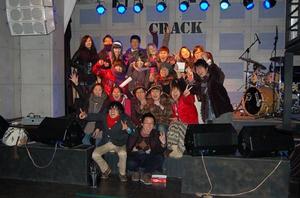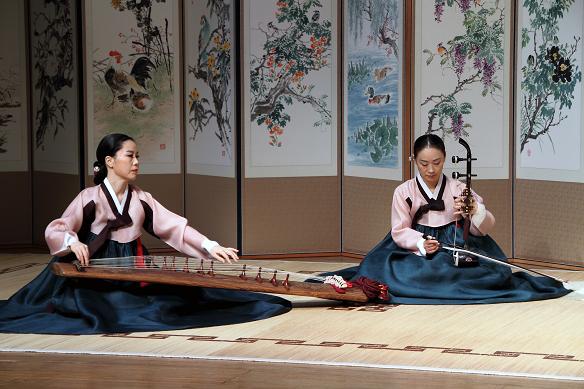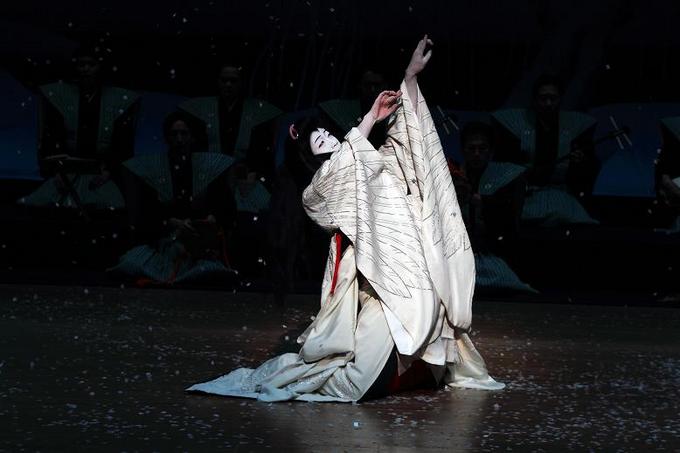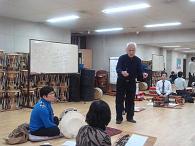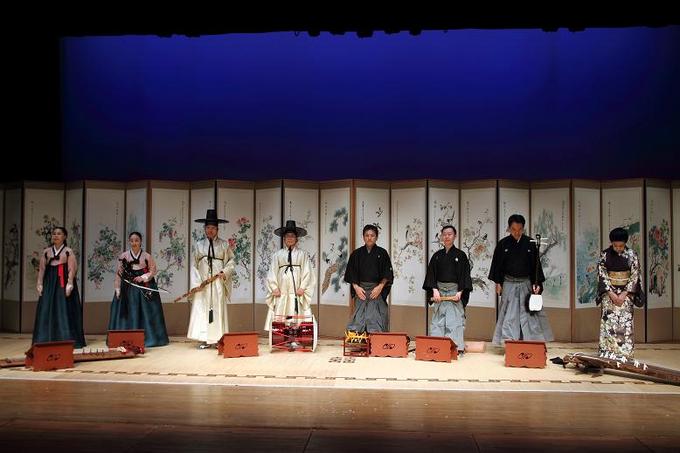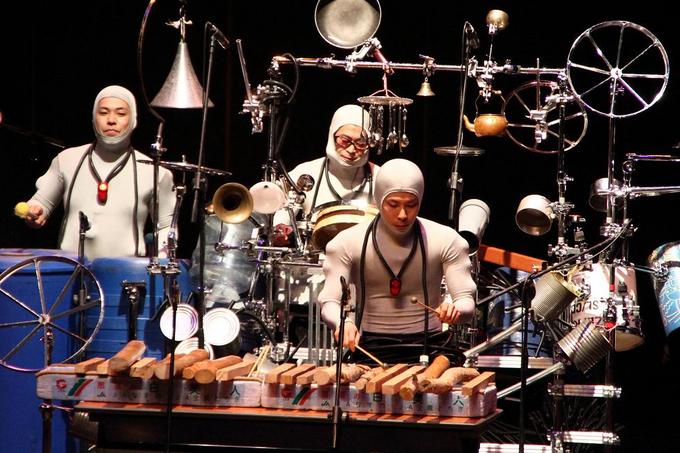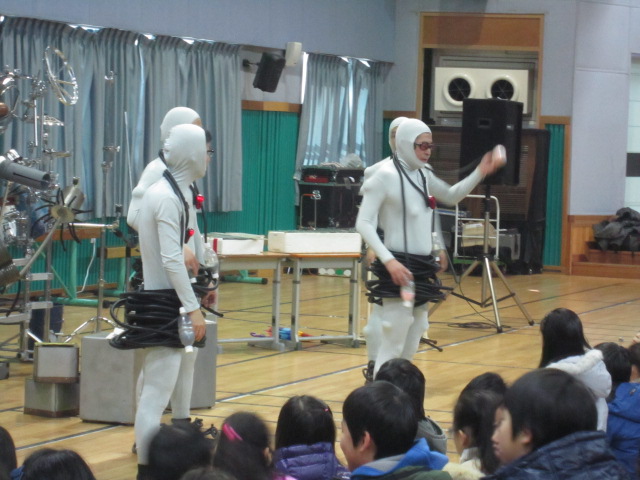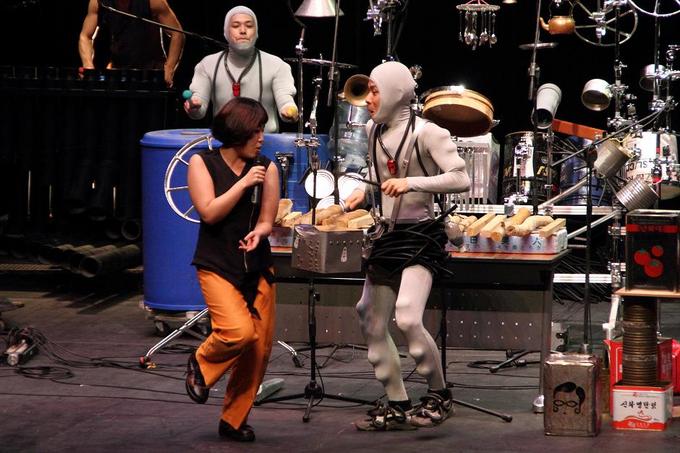Looking Back on the New Era: Japan-Korea Collaboration for the Future Project
Hiroki Yamasaki
The Japan Foundation, Seoul
 The words "K-J Collabo" appear on the world's largest LED canvas set up as part of an event called "Seoul Square Media Canvas J-K Collaboration."
The words "K-J Collabo" appear on the world's largest LED canvas set up as part of an event called "Seoul Square Media Canvas J-K Collaboration."In 2011, a series of events titled "The New Era: Japan-Korea Collaboration for the Future" was organized in the Republic of Korea. The aim was to help both countries strive to forge a new bilateral relationship. Events in a wide range of fields, including exhibitions, performances, film screenings, youth education programs, symposia and lectures, took place in Seoul and five other cities from February to March 2011. (The project was sponsored by the Japan Foundation and co-sponsored by the Ministry of Foreign Affairs of Japan with its embassy in Seoul.)
The term "collaboration" has many meanings. This project focused on collaborative activities between people or groups of people in Japan and Korea. It also looked at efforts on both sides to overcome their common issues, such as tradition and modernity, nature and science/technology, multicultural symbiosis, welfare and the environment. We were able to carry out the events with the help and co-sponsorship of many specialists and organizations in Korea, and the project was worthy of its title of "The New Era."
14 Events to Shed Light on Modern Aspects of Japan and Korea
Each event was designed to provide opportunities to look into modern aspects of Japan and Korea from different angles. In the field of fine arts, for example, we introduced a variety of contemporary artistic expressions by organizing exhibitions and other events. These included an exhibition titled "Manga Realities: Exploring the Art of Japanese Comics Today" that featured Japanese manga drawn after 2000; another exhibition titled "WA: The Spirit of Harmony and Japanese Design Today" that gave an overview of Japanese product design from diversified perspectives; and the "Seoul Square Media Canvas 2011 J-K Collaboration" event, in which works produced jointly by Japanese and Korean media artists appeared on the world's largest LED canvas installed on the façade of an enormous building in front of Seoul Station. We also sponsored the "Ware Ware! Korea Japan Film Festival," in which a selection of movies, both old and new and relating to Japan and Korea, were shown with plenty of guest talks. The festival provided the film industries of both countries with a new perspective. Meanwhile, the Japan-Korea Blastbeat Project was an attempt that let college students from both countries set up a mock company and organize music events. The youngsters met many times and carried out music events in both countries. There were also events that shed light on many different aspects of culture: a symposium on Japan-Korea interchange in publishing, where we delved into the extent to which Japanese and Korean novels have been introduced to each other's country, and a symposium to take another look at how J-pop and K-pop are accepted by people in Korea and Japan respectively. (We had to postpone the seminar on multicultural symbiosis in the cities of Japan and Korea and the final symposium for the Japan-Korea Blastbeat Project because of the Great East Japan Earthquake that struck right before they were scheduled to take place.)
Now, I would especially like to elaborate on two of the many events. One is the Japan-Korea Traditional Performing Arts Festival, which saw the first ever collaborative performance by Japanese and Korean artists in traditional music. The other is the Ticobo Eco Concert Tour in Korea, which brought together Japanese and Korean bands that perform on percussion instruments made from waste materials.
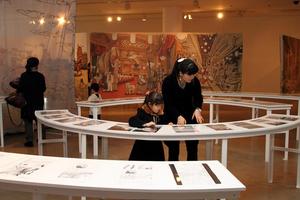
The exhibition "Manga Realities: Exploring the Art of Japanese Comics Today"
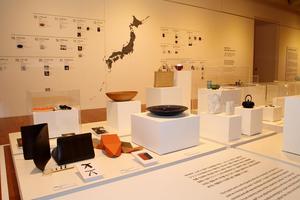
The exhibition "WA: The Spirit of Harmony and Japanese Design Today"
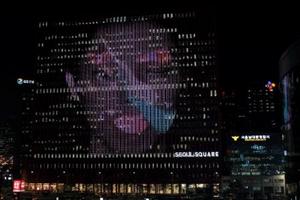
Seoul Square Media Canvas 2011 J-K Collaboration
Historic Collaboration between Top Japanese and Korean Traditional Performing Artists
Both Japan and Korea have an impressive array of traditional performing arts. The two countries, though, find it difficult to maintain their traditional communities in a world of increasing globalization. They face the common task of figuring out how to pass on and develop the communal skills and cultures to the next generation. Traditional performing arts, however, have been divided into fixed genres, so it is extremely difficult to promote interchange between those genres, let alone interchange with other countries. Against this background, we took on the challenge of facilitating collaboration between Japanese and Korean artists in the field of traditional music, both of whom face the same problems, by organizing the Japan-Korea Traditional Performing Arts Festival.
The festival took place first in Seoul and then moved to Busan, with performers belonging to the National Center for Korean Traditional Performing Arts (National Gugak Center) in each place performing in collaboration with artists from Japan. The National Gugak Center, which co-sponsored the event, was established in 1951 amid the Korean War, to promote and preserve traditional Korean music. The Japan-Korea Traditional Performing Arts Festival was one of the events to celebrate its 60th anniversary.
The festival was made up of three parts. In the first part, a number of Korean songs (including Tapyeongga) and a Japanese Nagauta (long epic song) (Akino Irokusa) were sung. The second part featured a Korean dance (Hak Cheoyongmu) and a Japanese dance (Sagi musume). The third and final part was devoted to an endeavor nobody had ever experienced before; musicians from Japan and Korea gave an improvised joint performance making use of Sinawi, a traditional Korean form of improvising music. They jointly played the melodies of Yachiyojishi and Yeombuldodeuri that have been handed down over the ages in Japan and Korea respectively.
The unprecedented series of collaborative performances was made possible through the participation of talented young artists from Japan and Korea who bear the future of traditional performing arts in their countries. Among them was 20-year-old Nakamura Kazutaro, a traditional Japanese dancer. His grandfather is Kabuki actor Sakata Tojuro IV, a living national treasure; his father is Nakamura Kanjaku V, also a Kabuki actor; and his mother Adzuma Tokuya heads the Adzuma school of traditional Japanese dance. His distinguished background and high level of skill make him the hope of the Japanese traditional dance world.
The Japanese and Korean artists eagerly prepared for their joint performances by getting together in Seoul a month in advance and practicing. Thanks to these efforts, the songs, dances, and other performances all had an overwhelming impact. Nakamura Kazutaro's performance of Sagi musume in particular often earned enthusiastic calls and applause from the audience. Cheers erupted whenever he quickly changed his costume on stage using a special method called Hikinuki. Some of the members of the audience were so moved by his dance that they came to see the performance twice.
The highlight of the festival was an improvised joint performance given by players of traditional string instruments and drums from Korea and Japan. These included Haegeum and Shamisen (banjo-like instruments), Gayageum and Koto (both resembling a zither), and the Janggu and Tsuzumi drums. The musicians played the instruments in a call and response pattern, demonstrating the virtues of each instrument, and the audience was treated to a wonderful performance full of harmony. It seemed that this historic attempt created a lasting connection between the performers.
Playing Percussion Instruments Made of Waste Materials to Raise Eco-Awareness among Children
Next, I'll elaborate on the Ticobo Eco Concert Tour in Korea that included a concert in which the Japanese percussion unit was joined by Noridan, a Korean musical and performing group. Both groups are popular for their performances using instruments made of waste materials found in our everyday lives. The Ticobo members also toured elementary schools in various parts of Korea (Seoul, Daegu, Busan, Guangju and Jeju Island) to make children who will lead the next generation more interested in environmental issues.
Ticobo not only performed on the percussion instruments they had made from waste materials by themselves but also provided easy-to-understand explanations about each instrument, which thrilled the audience. They showed how the things we usually throw away have much potential when used cleverly. They performed together with some members of the audience using newspaper and an instrument called the "Pekker" they made of plastic bottles. It was a performance where the audience could think about environmental issues in a fun way through cultural activities. Tiboco's performances in various parts of the country were covered by a number of Korean newspapers and television stations.
About 500 second- to fourth- graders gathered for the concert held at the gymnasium of Song Jeong Primary School in Seoul. The children were startled by Ticobo's bizarre outfits, but soon became absorbed in the fun performance. Tomo Yamaguchi, the Ticobo leader, introduced each instrument and showed the children how to make sounds with some newspaper. A member of the Japan Foundation staff interpreted for him wearing the same outfits as the Ticobo members. The children responded with smiles and listened to the explanations intently. They enjoyed imitating the gestures and body movements of the Ticobo members. The members were particularly surprised at how energetically the children performed when they played the Pekker together. Ticobo received many thanks from the principal and teachers after the concert, and all of the members were then invited to eat school lunch with the pupils.
The school's 2011 calendar carries a photograph of the performance. Perhaps Ticobo's ideas about being environmentally friendly left a strong impression on the hearts of the children.
Calls for an Encore Followed by Joint Improvised Performance by Ticobo and Noridan
Ticobo and Noridan use the same musical style when they perform in Japan and Korea respectively. A joint performance by the two was in the works six years ago, but it never happened. The concert in Seoul was the first time the two groups played together.
Many parents took their children to the concert at the Guro Arts Valley Theater, and all the tickets were sold out. The concert began with Noridan's performance; the members beat bicycle pumps, chairs and parts of their own bodies to make sounds. Ticobo followed by playing their instruments, talking to the audience and performing with the children on the stage. A fun atmosphere prevailed at the venue in no time. This can be described as a moment when a sense of collaboration was created between the audience and performers, as well as between the performers themselves. Ticobo and Noridan played one piece of music together at the close of the concert. The performance drew a particularly long and enthusiastic round of applause with calls for an encore. They responded by improvising the music, in addition to the two pieces of music that had originally been set aside as encores. It seemed that the impromptu encore fully demonstrated the exceptional flexibility and talent that the members of both groups had.
The joint performance was not just about the two groups playing together, but it enabled them to interact with each other and impress the audience deeply in a way that they couldn't have done if they had played separately. Given that Ticobo and Noridan were subsequently approached as to if they were willing to play together again, the concert ended up preparing the ground for their future collaboration.
Overcoming Difficulties Caused by the Earthquake
"The New Era: Japan-Korea Collaboration for the Future" project provided many people with the chance to see the frontline of cultural interchange between Japan and Korea. It also helped create networks of those who bear the futures of various cultural fields in the two countries. The events included in the project were covered by many media outlets, making it a success overall. It was, however, unfortunate that the Great East Japan Earthquake struck on March 11 when the project was under way.
We can't forget, though, the warm support and aid that many people in Korea provided for the people affected by the disaster. We would like to take this opportunity to thank the people who expressed their sorrow and sympathy to Japan. I believe that the Koreans who aided Japan aim for the same future that the "New Era: Japan-Korea Collaboration for the Future" project aimed for. I hope that what has been achieved through the project will contribute to Japan's recovery and the further development of ties between Japan and Korea.
Back Issues
- 2025.6.24 Exclusive Interview:…
- 2025.5. 1 Ukrainian-Japanese I…
- 2024.11. 1 Placed together, we …
- 2024.5.24 The 50th Japan Found…
- 2024.5.24 The 50th Japan Found…
- 2024.5. 2 People-to-People Exc…
- 2024.2.19 Movie Theaters aroun…
- 2024.2.19 Movie Theaters aroun…
- 2023.4.24 The 49th Japan Found…
- 2022.10.24 Inner Diversity <2> …


